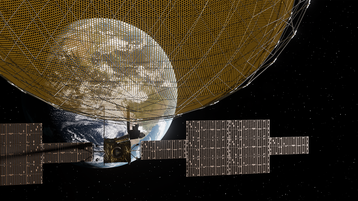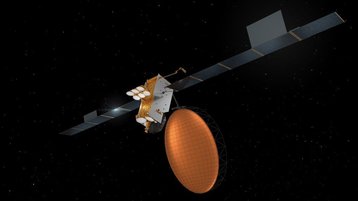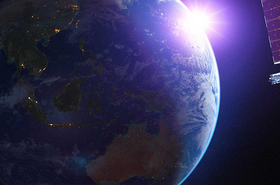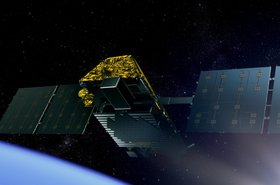Satellite operator Viasat won’t replace a struggling satellite after a fault massively reduced its throughput capacity, but it is expecting to file an insurance claim - alongside a similar claim for an ailing Inmarsat satellite
ViaSat-3 F1 is intended to be the first in a constellation of three geostationary Ka-band communications satellites. F1 is intended to cover for the Americas, with future satellites covering EMEA, and APAC. The satellites are each expected to have a throughput of more than 1Tbps and download speeds of 100+ Mbps.
F1 was launched in May 2023 aboard a SpaceX rocket, but an "unexpected event” during reflector deployment hit its performance.
Viasat has now said that the satellite payload is functional, but it expects the constellation to handle “less than 10 percent” of its planned throughput.
Despite this, ViaSat is not planning to replace the satellite, saying that it can adapt the system to mitigate the lost capacity.
“With the flexibility and agility of its integrated satellite fleet, the limited ViaSat-3 F1 capacity, the addition of the next two ViaSat-3 generation satellites, ground network mitigations, and third-party bandwidth commitments, the company remains confident that it will meet the current and future needs of its mobility customers and is well-positioned to achieve its financial growth objectives,” the company said.
Viasat also confirmed that it has insurance coverage of $420 million in place for ViaSat-3 F1 and will finalize its claim before the end of the year.
Speculation on X (formerly Twitter) suggests that ViaSat may shift the satellites, with a post from Lukas C.H suggesting the company may move one of the other two ViaSat-3 satellites to cover the Americas, and shift F1 towards the APAC satellite’s planned position.
ViaSat's subsidiary Inmarsat had a similar issue in August when its I6 F2 satellite suffered a "power subsystem anomaly" after launch, during its orbit-raising phase. Viasat closed its acquisition of Inmarsat earlier this year.
The 5.47-ton I6 F2 – based on Airbus Defence and Space's Eurostar E3000e platform – was launched in February 2023 and was set to have a 15-year lifespan. The satellite was intended to offer four Gbps of additional Ka-band capacity to Inmarsat’s network as well as L-band services over the Atlantic.
Viasat said it has insurance coverage of $348 million in place for the I6 F2 satellite and will finalize its claim before the end of the year, and will be funding to replace the lost capacity.
Four more satellites facing issues
Earlier this month, SpaceNews reported four other satellites may be in potential trouble.
According to multiple insurance sources, Yahsat’s Al Yah 3, Avanti Communications’ Hylas 4, and Northrop Grumman’s two Mission Extension Vehicles (MEV-1 and MEV-2) are operating with reduced power to their thrusters following a problem with onboard Power Processing Units (PPUs).
The PPUs from Aerojet Rocketdyne – recently sold to L3Harris – provide the electrical power their thrusters need for station-keeping in geostationary orbit (GEO).
One of the sources said Al Yah 3, Hylas 4, and MEV-2 have each lost one of two onboard PPUs since the issue emerged in 2022. The youngest of these spacecraft, MEV-2, launched in 2020.
The faults will not cause the machines to fail altogether, but will likely impact their 15-year lifespans. All four were built at Northrop Grumman’s facility in Dulles, Virginia.
SN reports the issues could result in at least $50 million in insurance claims, on top of the potential $800 million potentially to be paid out for other failures this year.
Aerojet Rocketdyne and satellite builder Northrop Gruman declined to comment to SN.
This summer also saw Astranis' Arcturus suffer a solar panel issue, again offering severely reduced capacity and likely another insurance claim.
In other Geostationary satellite news:
- SES has appointed Adel Al-Saleh as the company’s new CEO, effective February 2024. He joins from Deutsche Telekom’s T-Systems International, which he had led since 2018. Al-Saleh was previously at IBM for close to 20 years before taking positions at IMS Health and Northgate Information Solutions.
Interim SES CEO Ruy Pinto will continue until the changeover before moving to an advisory role. Previous CEO Steve Collar stepped down in June 2023.
- Eutelsat has pledged to reduce its energy-related greenhouse gas (GHG) emissions (Scopes 1+2) by 50 percent by 2030 compared to a 2021 baseline.
- Eutelsat has signed a multi-year agreement with Marlink. The maritime communications provider will lease Ku-band capacity on the operator’s Eutelsat 10B satellite over EMEA.
- Banking group Intesa Sanpaolo has invested in SpaceX. The size of the investment wasn’t shared.
- Google spin-out Aalyria has formed a strategic alliance with government technology supplier Second Front Systems. Aalyria will integrate its technology with Second Front's Game Warden platform.
- Satellite tracking firm Slingshot Aerospace has warned that Russian satellite Luch (Olymp) 2 is making maneuvers to ‘park’ next to other GEO satellites. The satellite was launched in March 2023 and has drifted past – as close as 16km – a number of GEO satellites. The satellite’s predecessor, Olymp 1, launched in 2014, performed a number of similar flybys in its time.
- Mongolia has ordered a new telecommunications GEO satellite from Thales Alenia Space.
- Arabsats's BADR-8 / Arabsat 7B satellite is now operational.








